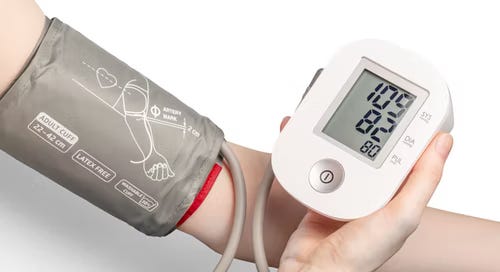Are At-Home Blood Pressure Monitors Accurate?
At this very moment, thousands of people all over the world are sitting in doctor’s offices with blood pressure cuffs strapped to their arms. If you’ve ever set foot in a medical facility, I’m sure you’re very familiar with the python-like squeeze followed by the slow return of circulation as blood flow returns to your bicep.
Yet, despite this dramatic description, getting your blood pressure checked is relatively simple compared to other medical office procedures, such as a hernia check.
At the same time, in millions of homes across the globe, other people are engaged in similar fun, monitoring their blood pressure with an at-home device. Maybe they’ve been instructed to do this type of home monitoring because their “numbers” are borderline, or perhaps they have been diagnosed with a full-blown case of hypertension.
If you have been instructed to monitor your blood pressure at home, you might be wondering if at-home monitors are as reliable as the devices used in clinic settings. And if so, which at-home monitors are the best? Also, what about those blood pressure kiosks at drug stores or pharmacy departments?
Scientists test the devices
Recently, researchers from Kaiser Permanente set out to answer those questions and came up with some interesting findings. To conduct the study, the scientists compared clinic, at-home and kiosk-based blood pressure measurements to 24-hour ambulatory BP monitoring (ABPM) — a device that automatically measures blood pressure throughout the day and night.
The scientists discovered that compared to ABPM readings, average blood pressure readings were lower in clinic settings and significantly higher at kiosks. However, at-home blood pressure monitors yielded results more in line with ABPM readings.
This means that because clinic-based blood pressure readings were consistently lower than the ABPM readings, it may lead to hypertension being underdiagnosed. In contrast, the typically higher readings produced by the kiosk machines may indicate there’s a problem with blood pressure when none exists.
Researchers concluded that at-home monitors may be very effective for diagnosing high blood pressure or keeping track of blood pressure in people with hypertension. However, this leaves one question unanswered. Which at-home monitors are reliable and accurate?
Fortunately, the American Medical Association (AMA) has developed a process in partnership with the National Opinion Research Center at the University of Chicago (NORC) to identify and list which at-home blood pressure monitors meet the AMA’s criteria for accuracy. This entire list can be found online at https://www.validatebp.org/.
However, here are a few of the brands and model numbers mentioned:
ForaCare: Fora TN’G BP (P80)
Smart Meter: iBloodPressure (SMBP802-GS-001)
Greater Goods: Greater Goods BP (0040, 0604, 0664)
BodyTrace: Blood Pressure Monitor (BT105)
CareSimple: Blood pressure Monitor (BT105)
Transtek: (LS802-GS, LS802-GP)
Omron Blood Pressure Monitor: (HEM-9210T, HEM-9200T, BP7000, BP7250, BP7200, BP7100, BP5450, BP5350, BP7450, BP7350, BP5100, BP5250, BP7900, wrist models BP6350, BP6100, BP4350, BP8000-M)
Hillrom-Welch Allyn: 1700 Series (H-BP100SBP)
What should blood pressure numbers be and how do you ensure you’re getting accurate readings?
According to the latest recommendations, normal blood pressure is less than 120/80 mmHg. Blood pressure considered elevated is 120-129/less than 80 mmHg. After that, Stage 1 Hypertension is 130-139/80-89 mmHg, and Stage 2 Hypertension includes readings of more than 140/greater than 90 mmHg.
However, plenty of factors can get in the way of an accurate reading, especially when using an at-home device.
For example, if you’re feeling stressed, recently had caffeine or exercised, blood pressure readings can register a bit higher. So, suppose you’ve just slammed an espresso while running up a flight of stairs in a rush to make a meeting with your boss. In that case, it’s probably not a good time to wrap a blood pressure cuff around your arm if you’re hoping for an accurate reading.
Instead, for more accurate numbers, the American Heart Association says to avoid smoking, drinking caffeine and exercise within 30 minutes before sitting down to take your blood pressure.
Additionally, they recommend emptying your bladder and then sitting in an upright position with your feet flat on the floor, resting your arm on a surface at heart level for five minutes before taking a measurement.
Furthermore, checking your blood pressure throughout the day, preferably at the same time each day, can help give you an accurate overall picture of your numbers.
So, whether your doctor wants you to keep track of your blood pressure, or you just want to keep an eye on it yourself, luckily, with the accurate at-home blood pressure devices available, it’s now easier than ever. Not only is it simple to do, but it’s also an excellent way to take charge of your health.




